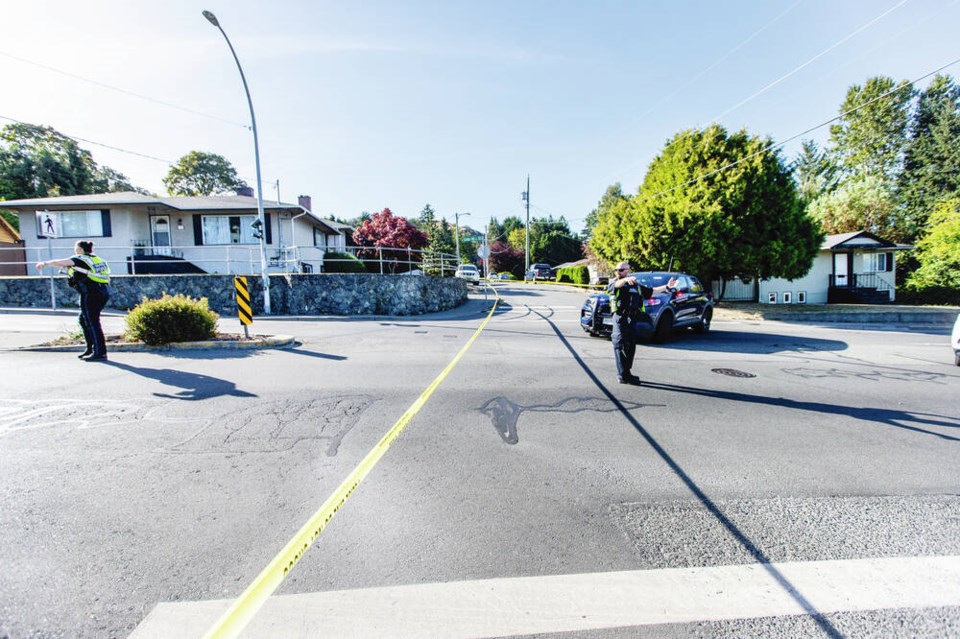Regular TC readers will know that there has been a spate of troubling pedestrian accidents in Saanich during the past year.
I have only the media releases provided by Saanich police to go on, but based on what I’m reading, “troubling” is the appropriate word.
Many of these vehicle-versus-pedestrian incidents seem to have occurred during daytime when the weather was nearly perfect. Many of them occurred in marked crosswalks covered by both signs and “pedestrian crossing” warning lights.
In most cases, thankfully, drivers retained the good sense to remain on scene and help the victims and/or the cops in their investigations.
But based on the media information presented to date, you have to ask: “What’s going on?”
I’m going to assume for the moment that these pedestrians weren’t darting out, making it impossible for a driver to react in time, which does actually happen, perhaps a little too often.
So if it isn’t about darting out and the weather is perfect, we have to look at the driving side of this equation. I’ll stand to be corrected on any of my assertions here when the investigations show what actually happened, but for now, driving seems to be where the problem lies.
One of the biggest causes of pedestrian incidents is driver distraction. The smartphone is now a mainspring in the distraction game, but it can come in other forms, too.
Obviously painting your nails or buttering that piece of breakfast toast with extra-crunchy peanut butter, while doing 50 km/h, are right up there in the Distraction Hall of Fame.
Distraction can come just as easily from pushing the brain too far towards how you’re going to get through traffic to make that ferry sailing. It can also be as simple as trying to glance at the grocery list or rushing to be on time for soccer practice.
Speeding is another one of the major things that is lethal to pedestrians. Even a few kilometres over the limit reduces a driver’s reaction time dramatically, and of course, we’ve now heard time and time again that the faster, and therefore harder, we hit a pedestrian, the less chance they have of surviving.
For me, one that’s not talked about enough is passing another car that has made a sudden or unexplained stop. This is a particularly dangerous scenario on a multi-laned roadway, which I’ve written about before.
Many vehicle-versus-pedestrian incidents are recorded as the driver simply failing to yield to someone in a crosswalk. However, many of these events happen when a driver fails to see the danger of passing a stopped car only to find, usually to their horror, that a pedestrian is now directly in front of them, and there’s no way to stop.
We manage to kill around 300 pedestrians a year in this country and injure about 20,000 more in collisions with vehicles. Certainly drivers are not always to blame and pedestrians have to get into the game as well. After all, against a vehicle, the pedestrian always loses, regardless of fault.
We’re heading into the worst months now for pedestrian deaths and injuries. It’s time to slow down, make eye contact, wear more than all black at night and most of all, bring all of your attention to the road, whether driving or walking.
Glove Box: Sarah wrote last week with a question about merging onto a highway. That’s becoming more difficult with the volume of traffic flowing in and out of town every day.
There are a few points that can make things easier when merging at highway speed.
1. Use the on-ramp to match speed with cars already on the highway. Too often, I’ve seen people slow down or even stop at the end of a merge lane. That’s very dangerous. If you match highway speed on the ramp, you have much more ability to slip into an open space.
2. Signal your merge. If you use your signal, you leave no doubt for other drivers about your intention.
3. Be confident. It’s a tricky maneuver, especially in heavy traffic, but by following the steps above, you have the best chance of merging. Unless it’s an emergency, don’t slow suddenly or slam on the brakes at the end of the merge lane. There may be cars behind you and if you stop, you’ve just lost all of your runway to achieve merging speed again.
4. Shoulder check before entering a highway lane. Sometimes there’s that one person who won’t give you room and you are required to yield to the through highway traffic when merging from an on-ramp. If that person needs to be in front, let them, and fall in behind with a smooth merge.



